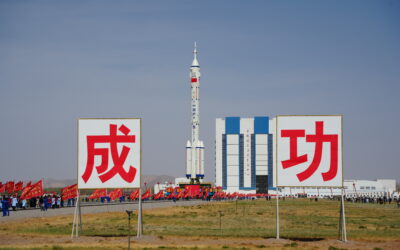
The Long Arm of China’s Security Services
SUBSCRIBER+ EXCLUSIVE REPORTING — When Chinese President Xi Jinping came to San Francisco last November to meet with President Joe Biden, Chinese pro-democracy activists in […] More
Zachery Tyson Brown is an intelligence and national security futurist interested in the many ways in which intelligence, strategy, organizational design, and disruptive technologies intersect. A veteran military intelligence analyst who served in both Iraq and Afghanistan, Zach is now a National Security Fellow at the Truman National Security Project, a proclaimed U.S. Army Futures Command “Mad Scientist,” and a Board Member of the Military Writers Guild.
OPINION — The U.S Intelligence Community needs a new business model, one that’s better suited for an era inundated with useful information and characterized by the demand for radical transparency. The next generation of national security leaders will, quite simply, expect more—more personalization, more collaboration, and more convenience.
Intelligence officers will likely bristle at the metaphor—intelligence isn’t a business, after all. But borrowing a few concepts from the private sector can help intelligence leaders better understand the successive waves of disruption that are right now undermining the very foundations of their vital institution.
Business models are stories about how an enterprise works. They are built from assumptions about the competitive environment and the kinds of problems that customers need to solve. Good business models have compelling value propositions that explain how a potential product or service solves those problems. Simply put, successful businesses offer better solutions than their competitors.
When the intelligence community was established at the beginning of the Cold War, its business model and value proposition were straightforward. Postwar intelligence architects held the then-reasonable assumption that only a well-funded, centralized conglomerate could build and maintain the prohibitively expensive technical collection platforms that were then necessary to pierce the Iron Curtain and acquire useful information about the Soviet Union. Borrowing what were at the time best practices from the private sector, they built, over the years, a multi-divisional hierarchy of agencies, each a semi-autonomous unit with its own customer base and ‘brand’ to manage. At the top of this industrial decision-making mechanism sat the National Security Council, a body originally intended to be a coordinating forum but that instead quickly morphed into something more like a board of directors.
Throughout the Cold War, the assumptions that buttressed the intelligence community’s business model held because the most useful information—think war plans and missile designs, for example—remained in the hands of a relatively small number of Soviet and Warsaw Pact elites. Unassailable barriers to entry prevented any serious competition, to the intelligence agencies themselves, and the general scarcity of information regarding the Soviet threat meant the intelligence community’s views were at least heard if not always adhered to. The community effectively enjoyed a monopoly—or, more precisely, an oligopoly—over its mission “to inform national security decisions.”
Today however, in sharp contrast to the Cold War era, useful information is now quite literally everywhere. Rather than belonging to few, it can come from practically anyone, practically anywhere on earth. And due to the growing complexity of international affairs, more information does not necessarily equate to better decisions.
Sooner or later, every business model fails. They are disrupted—which literally means broken—either naturally by changes in the competitive environment, or artificially by the emergence of competitors with a better model that renders the old one obsolete. That model might involve the use of a new tool or a faster process, or even just a more efficient internal organizational structure that allows the business to better solve its customer’s problems.
The private sector is replete with examples of business model disruption, but the one most salient to the intelligence community is that of 20th-century photography giant Eastman-Kodak. Kodak’s tragedy is the story of an institution whose biggest impediment to adaptive change was its legacy of success—just like the intelligence community.
Kodak’s century-long domination of the industry ultimately prevented its leaders from embracing the future. These executives weren’t stupid, mind you. They knew that the future of photography was digital. In fact, they themselves had invested billions of dollars to develop the technology. But because Kodak’s business model was designed to profit from every aspect of analog photography—from the cameras and the flashcubes to the film they used and even the paper the photographs were printed on—its executives were reluctant to change. This hesitance resulted in a half-hearted modernization strategy that needlessly ceded customers to nimbler industry outsiders. It led, eventually, to the company’s collapse.
Like Kodak, the intelligence community’s leaders know the world has changed. Like Kodak, the agencies they lead collectively ‘own’ every aspect of the intelligence production cycle—from the satellites in orbit and the technicians who exploit them, to the analysts who refine that data into so-called ‘finished’ intelligence and even the distribution channels and security protocols that determine who gets to see it. Just like Kodak, the intelligence community’s last-century business model is beginning to be broken by competitors it’s never before had to face.
The information revolution sparked the growth of an ecosystem of these competitors, firms who offer not only intelligence-like products such as news aggregation and data analytics, but some who offer full-on strategic intelligence services like on-demand satellite imagery and long-term strategic forecasting of geopolitical conditions. Private firms like Bellingcat have blurred the line between journalism and intelligence, pioneering the open-source techniques that exploit social media, commercial imagery, and so-called gray literature—often using these techniques to beat the intelligence community at its own game, at least in terms of speed and accessibility. And while the intelligence community’s leaders might comfort themselves by saying these techniques aren’t as sophisticated or authoritative as what they themselves can provide, the fact is that Kodak’s leaders believed the same thing—and they eventually learned that it didn’t matter because speed and accessibility win every time.
Kodak’s leaders belatedly discovered that while their path of least resistance was up—building a better, more expensive camera every year—the most dangerous threats to their business model came from below. No one denied that Kodak’s cameras were qualitatively superior to the newer digital alternatives. It didn’t matter in the end, though, because the alternatives were cheaper, faster, and just plain easier to use.
The reason disruptive innovations are so disruptive is that big, successful institutions are often blinded by their very success. As their business model becomes dominant, they are tempted to mistake their way of doing things for the way of doing things. By continuously improving their products, they facilitate commoditization, which eventually lowers the barriers to entry for competitors even as it overshoots the minimal functionality the majority of users need. They then often then find themselves immobilized by the sunk costs of their legacy investments, unable to invest in the new or appeal to new users who increasingly can’t afford or aren’t interested in their increasingly-exquisite products.
The intelligence community’s version of Kodak’s better cameras is the trillions of dollars it has spent sustaining its Cold War business model. Over the years our intelligence agencies—eighteen of them now—have practically perfected their ability to gather information through an elaborate technical collection architecture. This globe-spanning armature of acquisition today costs the American people something like $80 billion every year and feeds, according to one admittedly rough estimate, the production of some 50,000 finished intelligence reports.
Unfortunately, however, many of these reports are left unread by anyone but other intelligence officers because the ‘sources and methods’ from which they’re derived require such strict security measures that only a small handful of people are even authorized to see them in the first place. The vast majority of the national security workforce—to say nothing of the rest of government—are effectively priced out, unable to access the fruits of the intelligence community’s labor. So, while intelligence officers like to think of themselves as “speaking truth to power,” the truth is that often they are only talking to themselves.
That wasn’t as much of a problem in the past, when decisions were more centralized and the general scarcity of useful information meant that the intelligence community, for all its flaws, was essentially the only game in town. But the problem of information scarcity no longer exists. In terms of the business model analogy, the competitive environment has changed, and so have the customers’ needs.
To be as successful in the information age as it as in the industrial one, the intelligence community needs a new business model that satisfies those needs. It needs a value proposition that solves the sort of problems today’s leaders have, and it needs to solve those problems in a manner that’s convenient for them. What leaders need help with most today is not gathering more information, but rather making sense of all the information they already have. For them, information is abundant but understanding is in short supply. Drowning in data, they instead thirst for insight.
A new intelligence business model will require us to reframe our conception of intelligence itself. Instead of seeing intelligence as a product that is delivered—the slide deck, the satellite image, the white paper—we should start thinking of intelligence as an intangible, continuous, and user-focused service that expands a user’s mental map of the world and helps them to navigate that world more easily. Rather than merely informing national security decisions through the delivery of a hard-to-find piece of information, it should empower intelligence officers to actively help policymakers make better ones. In short, we should start to view intelligence officers themselves as the product, and through collaboration with users creating more value for the national security enterprise.
To do that, the community must traffic in trust, and trust depends on transparency. Transparency doesn’t mean recklessly revealing national secrets or needlessly dragging skeletons out of closets. It does mean becoming much more comfortable operating ‘in the open,’ being much clearer about how analytic judgments were reached, and perhaps most importantly, speaking far more regularly—and plainly—to both the American people and their elected representatives. Going forward, intelligence can no longer be synonymous with secret information, or even with secrecy itself—the very notion of which is dying. Soon, there will be no more hiding in a transparent world that is always monitoring, always tracking, and always listening.
The intelligence community is well-positioned to adapt if it can muster the collective will to do so—intelligence officers are bright, diligent, and famously dedicated to the mission of protecting America’s national security interests. They have, through nearly two decades of war, performed admirably all over the world—often in austere conditions, and not infrequently under fire. Several of them have paid the ultimate price in defense of their country. But the community can’t afford to rest on its laurels. Today, past pedigree counts for little, and past accomplishment is no guarantor of future success. As former Principal Deputy Director of National Intelligence Sue Gordon puts it, “We’ve never been as good as we are now, but we have to be better.”
Ultimately, the business model analogy is just that—an analogy. The intelligence community is not a business, nor is it motivated by profit. But it should learn applicable lessons from the private sector, and its efforts should profit the nation.
The time to begin thinking about a pivot is long overdue.
Have a perspective to offer? Drop us a line at [email protected]
Read more expert-driven national security insights, perspective and analysis in The Cipher Brief
Related Articles

SUBSCRIBER+ EXCLUSIVE REPORTING — When Chinese President Xi Jinping came to San Francisco last November to meet with President Joe Biden, Chinese pro-democracy activists in […] More

SUBSCRIBER+EXCLUSIVE EXPERT PERSPECTIVE — More than two years after its withdrawal from Afghanistan, the U.S. still does not have a clear way forward in the […] More

SUBSCRIBER+ EXCLUSIVE REPORTING — Ukrainians greeted Saturday’s long-awaited House passage of $60.8 billion in aid with justifiable jubilation. For months, their soldiers, civilians, and political […] More

SUBSCRIBER+ EXCLUSIVE REPORTING — A race for control of space is underway, and just as on earth, the U.S. and China are the top competitors. […] More

SUBSCRIBER+ EXCLUSIVE REPORTING — For nearly a week, the Middle East and much of the world were on a knife’s edge, waiting for a promised […] More

BOTTOM LINE UP FRONT – Less than one week after Iran’s attack against Israel, Israel struck Iran early on Friday, hitting a military air base […] More
Search